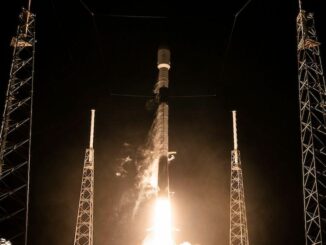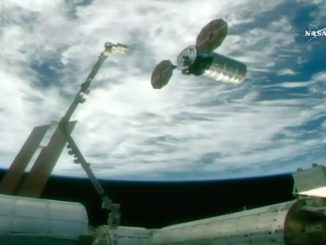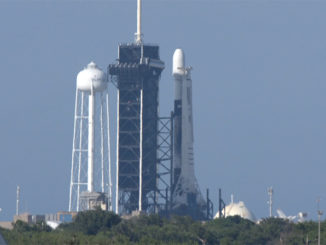EDITOR’S NOTE: Updated at 2 p.m. EDT (1800 GMT) after docking.

Completing a fast-track, three-hour pursuit of the International Space Station, a Russian Progress supply ship overcame a last-minute misalignment and autonomously linked up with with orbiting research complex Thursday with nearly three tons of fuel, food and supplies.
The Soyuz-2.1a rocket took off from pad 31 at the Baikonur Cosmodrome at 10:26:21 a.m. EDT (1426:21 GMT; 7:26 p.m. Baikonur time) with the Progress MS-15 cargo ship.
The mission’s launch was timed less than a minute before the space station flew directly over the launch base on the remote Kazakh steppe, allowing the Progress supply carrier to chase down the orbiting research complex in a little more than three hours.
The kerosene-fueled Soyuz launcher headed northeast from Baikonur and shed its four first stage boosters two minutes after liftoff. The Soyuz later released an aerodynamic shroud that covered the Progress supply ship, jettisoned its core stage, and ignited a third stage engine to deliver the cargo freighter into orbit.
A live video feed from a camera on-board the Progress spacecraft showed the Soyuz third stage shutting down its engine and separating nearly nine minutes into the mission. The Progress MS-15 freighter then unfurled its power-generating solar array wings and navigation antennas.
Liftoff of a Russian Soyuz-2.1a rocket from the Baikonur Cosmodrome with the Progress MS-15 cargo ship, carrying food, fuel and supplies on a fast-track flight to the International Space Station. https://t.co/TcC8qI1qXS pic.twitter.com/lVR0RRYwuW
— Spaceflight Now (@SpaceflightNow) July 23, 2020
Two major rocket burns using the Progress spacecraft’s thrusters occurred at at 11:04 a.m., 11:46 a.m., and 12:32 p.m. EDT (1504, 1546, and 1632 GMT) to begin raising its orbit to match the altitude of the International Space Station. Those maneuvers set the stage for the supply ship’s approach to the station and a flyaround maneuver to line up with the Pirs module on the Russian segment of the research laboratory.
Russian cosmonauts monitoring the supply ship’s final approach noticed the Progress spacecraft was drifting out of alignment with the docking target on the Pirs module, adding some tension to the final moments of the docking sequence.
Cosmonaut Anatoly Ivanishin asked if he should take manual control of the Progress spacecraft via a command panel inside the space station, which serves as a backup to the cargo craft’s automated Kurs rendezvous radar system.
“Are we going to switch to manual control, Moscow?” cosmonaut Anatoly Ivanishin radioed Russian mission control near Moscow.
“Stand by, we do not have a go yet,” mission control replied.
“OK, we are standing by,” Ivanishin said.
“Everything is nominal, Anatoly,” mission control later said. “Don’t do anything.”
Moments later, the Progress contacted the Pirs docking port at 1:45 p.m. EDT (1747 GMT), and ground teams confirmed a good connection between the cargo freighter and the space station.
Russia’s Progress MS-15 supply ship docked with the International Space Station at 1:45pm EDT (1745 GMT), overcoming a last-minute misalignment to wrap up a successful 3-hour, 19-minute journey from a launch pad in Kazakhstan. https://t.co/m5O7wBmsE6 pic.twitter.com/Ue2CNRONxR
— Spaceflight Now (@SpaceflightNow) July 23, 2020
The docking occurred 3 hours, 19 minutes after the mission took off from Kazakhstan, delivering some 2.8 tons (2.6 metric tons) of fuel, food, supplies and other equipment to the space station and its five-person crew.
Russian ground teams loaded 3,351 pounds (1,520 kilograms) of dry cargo into the cargo freighter’s pressurized compartment, according to Roscosmos, the Russian space agency. Roscosmos says there’s around 1,322 pounds (600 kilograms) of propellant aboard the Progress MS-15 spacecraft for transfer into the space station’s tanks, along with 926 pounds (420 kilograms) of water and 101 pounds (46 kilograms) of compressed gas to replenish the space station’s breathing air.
The Progress MS-13 supply ship, which docked with the space station Dec. 9, departed the Pirs docking port July 8 to clear the way for the arrival of the new cargo freighter. After its docking Thursday, the Progress MS-15 spacecraft will remain linked with the space station until December, when it will detach and burn up in Earth’s atmosphere.
Ivanishin and and Russian flight engineer Ivan Vagner are joined on the International Space Station by Expedition 63 commander Chris Cassidy and NASA astronauts Bob Behnken and Doug Hurley.
Cassidy, Ivanishin and Vagner launched in April aboard a Russian Soyuz crew capsule. They are scheduled to return to Earth in October.
Behnken and Hurley launched May 30 from the Kennedy Space Center in Florida on the first flight of SpaceX’s Crew Dragon spacecraft with astronauts. They reached the station May 31, and are gearing up for undocking as soon as Aug. 1, followed by re-entry and splashdown off the Florida coast Aug. 2.
Email the author.
Follow Stephen Clark on Twitter: @StephenClark1.



